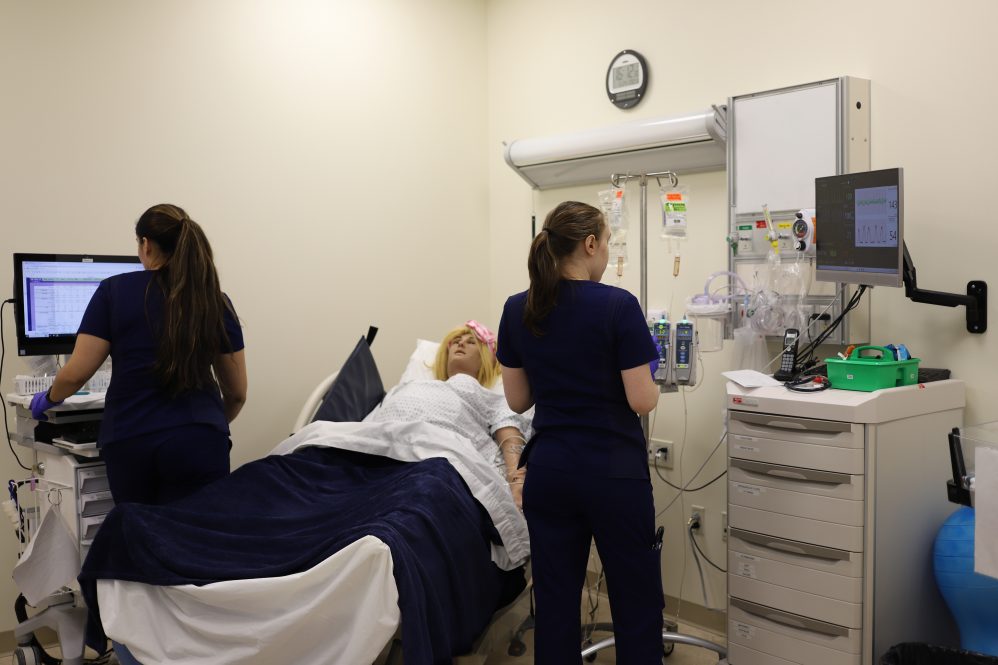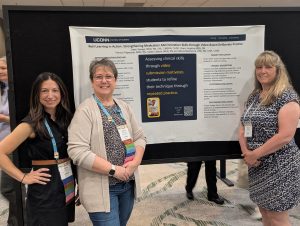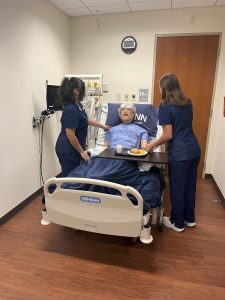Enhancing clinical competency and building confidence in nursing students with the use of emerging simulation technology.

UConn School of Nursing students in the simulation lab with a high-fidelity maternity mannequin on April 4, 2025. (Emily Laput)
This summer, members of the UConn School of Nursing simulation team, including Valorie MacKenna, Ph.D., RN, CNE, CHSE, and Dawn Sarage, MSN, RN, CNL, represented UConn at the International Nursing Association of Clinical Simulation and Learning (INACSL) conference.
INACSL has over 3,000 members worldwide all dedicated to advancing healthcare simulation through science. This year's conference was held in Denver, Colorado from June 19-22, and the theme was "Elevating the Simulation Experience."
"The conference brings together simulation educators and researchers from all around the country and world. It's a nice place where like-minded people share and learn from each other on what the best practices are in simulation," said Sarage.

Simulation labs allow students to take what they've learned in the classroom and apply it in a safe environment where they can use their clinical judgment and decision-making skills, ask questions, and learn from their mistakes. This hands-on learning is essential in shaping clinical competency for nursing students, and instructors are always looking for ways to enhance their teaching practices.
Apart from the networking experiences that the conference offers, MacKenna and Sarage said it was validating to see UConn already implementing a lot of the simulation practices presented.
"Going to the conference and being updated on the latest and best practices is important for our faculty," said MacKenna. "It also gives us an opportunity to see where the current trends are and how we're ahead of the curve a little bit on some things."

Following a call for abstracts and peer review process, the conference planning committee invited the UConn School of Nursing simulation team to present two projects: a podium presentation titled "AIM for Innovation: Leveraging Multiple AI Tools to Enhance Nursing Simulations," and a poster presented by Sarage, MacKenna, Sherri Hopkins, MSN, RN, CMSRN, with co-authors Patricia Papacoda, MSN, RN, and Caitlin Clyburn, MSN, RN, titled "Reel Learning in Action: Strengthening Medication Administration Skills through Video-Based Deliberate Practice."
Their podium presentation showcased the various artificial intelligence (AI) tools the simulation team is using to enhance the delivery of immersive simulation activities among nursing students.
One way they have implemented AI is by using ChatGPT to help design patient scenarios. From that, they used the enhanced speech feature to embody interactive characters within some scenarios.
"We used it to portray a patient on the receiving end of a telephone call for a pre-operative interview, and in another situation, we used it to be the voice of a patient," said MacKenna.
AI can mimic a real patient that allows students to practice in an environment that is as close to reality. MacKenna gave an example of a patient experiencing alcohol withdrawal symptoms feeling distrustful of the healthcare team. She explained that AI can stay in character better than instructors, so when a student says or does something unexpected in a simulation, AI can give a more authentic response.

"Another way that we've used AI is in generating short video snippets to help set the story up in terms of the scenario that the students participate in," said MacKenna. "AI will create animated, lip synced, narrated video snippets of avatars using a predetermined script."
They've also used AI to assist in creating pre-briefing exercises in the form of a mini podcast. Instead of reading, students get to listen to the information before going into the simulation lab ensuring they are adequately prepared.
"We have deliberate practice sessions scheduled in our lab. Students can sign up, they can go in to practice their skills, and I wanted to find a way to get students to take advantage of those sessions," said Sarage.
The assignment they created involved students recording themselves doing a specific skill, the skill they focused on was drawing medication from a vial.
"To support students, I created a demo video of the skill, and even with two decades of nursing experience, I found myself re-recording it several times to ensure clarity and precision," said Sarage. "The process reminded me that repetition builds confidence, not just for students, but for seasoned nurses too."
MacKenna shared similar remarks saying it puts the agency on the student to decide how much time and effort they want to put into the assignment. "It takes the pressure away from just getting through the assignment or the activity to taking complete ownership over that skill and that's very powerful in terms of building confidence and competence," she said.
Another piece of technology used in the School of Nursing simulation labs are high-fidelity mannequins that can facilitate simulations for a variety of populations: pediatric, newborn, adults, etc. They serve as a learning tool offering students a hands-on, immersive experience.
The new School of Nursing building will have a Nursing Simulation Center with over 13,000 square feet designated to state-of-the-art simulation technology. The center will feature a health assessment lab, two skills labs, a home healthcare suite, eight simulation rooms, nine simulation debriefing rooms, and a virtual reality simulation room. This space will allow faculty to continue to lead the way in using emerging technologies to enhance clinical judgment and decision-making skills among nursing students.
"A big part of being lean, responsive, and fiscally prudent as educators is always looking for the greatest tools, but also the correct tools depending on what we're hoping to accomplish with our learners," said MacKenna. "The more ways they can rehearse, learn, and solidify the understanding of different skills they have to do, the better."
To learn more about the UConn School of Nursing please visit nursing.uconn.edu






